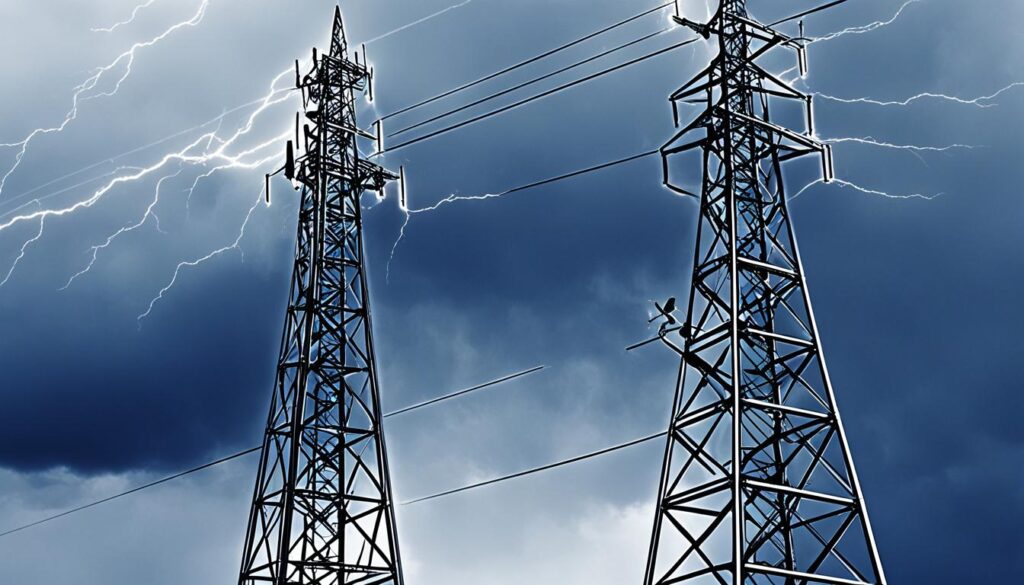Did you know that **80%** of IPTV network operators face disruptions due to unforeseen disasters?
When it comes to delivering uninterrupted IPTV services, disaster recovery is of utmost importance. IPTV networks are susceptible to a wide range of risks, including natural disasters, cyber attacks, and hardware failures. Without proper planning and strategies in place, these disasters can lead to significant downtime and customer dissatisfaction. In this article, we will explore the importance of IPTV disaster recovery and discuss actionable strategies that can ensure the reliability and resilience of your IPTV service.
Key Takeaways:
- Disruptions in IPTV networks due to disasters are prevalent among **80%** of network operators.
- Proper disaster recovery strategies are crucial to minimize downtime and maintain customer satisfaction.
- Assessing risks, implementing redundancy measures, and maintaining performance are essential elements of effective disaster recovery in IPTV networks.
- Executing and continuously reviewing the disaster recovery plan can enhance the resilience of IPTV networks.
- Robust data backup and business continuity planning are vital for ensuring uninterrupted IPTV services.
Understanding Disaster Recovery in IPTV Networks
Disaster recovery in IPTV networks plays a vital role in maintaining seamless service delivery and ensuring customer satisfaction. After a major disruption or disaster, such as network outages, natural calamities, or cybersecurity incidents, it is imperative to restore critical technology infrastructure promptly. This process, known as disaster recovery, involves recovering lost data, restoring system functionality, and minimizing downtime to protect the integrity of IPTV services.
The resilience of IPTV networks is crucial in safeguarding the continuity of service and addressing potential disruptions effectively. IPTV network operators must develop robust disaster recovery plans to facilitate a quick recovery and maintain normal operations. By implementing reliable disaster recovery strategies, network operators can mitigate the impact of unexpected events on their IPTV services, ensuring uninterrupted access for their customers.
To achieve IPTV network resilience, it is essential to have a comprehensive disaster recovery plan in place. This plan should include measures to minimize downtime, protect data integrity, and restore services efficiently. By considering various scenarios, such as hardware failures, network breaches, or power outages, network operators can identify the critical steps required to address each situation effectively.

The Importance of IPTV Service Continuity
Maintaining IPTV service continuity is of utmost importance for network operators. Interruptions in service can lead to dissatisfied customers and potential revenue loss. By implementing robust disaster recovery practices, network operators can minimize disruptions, exceed service level expectations, and differentiate themselves from competitors.
A key aspect of IPTV service continuity is maintaining redundancy within the network infrastructure. This can include redundant servers, network components, and data storage instances distributed across multiple locations. Redundancy ensures that if one component fails, the system can seamlessly switch to the backup, minimizing downtime and maximizing service availability for end users.
Additionally, proactive network monitoring is essential for early detection of potential issues. By regularly monitoring network performance, operators can identify and address any vulnerabilities or bottlenecks before they impact the service. This allows for preventative maintenance and proactive measures to ensure uninterrupted IPTV service delivery.
In conclusion, disaster recovery in IPTV networks is crucial for maintaining service continuity and minimizing downtime. By developing robust disaster recovery plans, implementing redundancy measures, and actively monitoring network performance, IPTV network operators can ensure uninterrupted access to their services. This not only enhances customer satisfaction but also strengthens the resilience and competitiveness of their offerings in the market.
Assessing Risks and Planning for IPTV Disasters
Before implementing disaster recovery strategies, it is crucial to conduct a thorough IPTV risk assessment to identify potential threats and vulnerabilities in your network. This assessment will help you develop a comprehensive disaster recovery plan that outlines specific actions to be taken in the event of a disaster.
An IPTV risk assessment involves evaluating various aspects of your network, including hardware, software, infrastructure, and operational processes. Identify any potential weaknesses or vulnerabilities that could compromise the reliability and continuity of your IPTV service.
Consider the following aspects during your risk assessment:
- Network infrastructure vulnerabilities: Assess the physical and logical infrastructure components of your IPTV network, such as servers, switches, routers, and firewalls. Identify any vulnerabilities that could disrupt service delivery or compromise data integrity.
- Software vulnerabilities: Review the software applications and systems used in your IPTV network. Ensure they are regularly updated and patched to address any known vulnerabilities.
- Data security measures: Evaluate the effectiveness of your data security measures, including encryption protocols, user access controls, and authentication mechanisms. Implement measures to safeguard sensitive customer data and prevent unauthorized access.
- Backup procedures: Assess the effectiveness of your data backup procedures. Evaluate the frequency and reliability of your backups to ensure critical data can be restored quickly in the event of a disaster.
- Redundancy measures: Examine the redundancy measures in place to minimize service disruptions. This can include redundant servers, network components, and data storage instances at different geographical locations.
Once the risks and vulnerabilities have been identified, it is important to develop a comprehensive disaster recovery plan that outlines the specific steps to be taken during a disaster. This plan should include:
- Emergency response procedures: Define the actions to be taken immediately after a disaster, including activating the disaster recovery team, notifying stakeholders, and initiating the recovery process.
- Backup procedures: Document the backup procedures to ensure critical data and content can be restored in a timely manner. Specify the frequency of backups, storage locations, and the process for validating backup integrity.
- Redundancy measures: Outline the steps to activate redundant systems in the event of a failure. This may include automatic failover mechanisms or manual interventions to switch to redundant components.
- Communication plan: Develop a communication plan that outlines how you will communicate with employees, customers, and stakeholders during a disaster. Define the channels of communication and the key messages to be delivered.
- Testing and training: Regularly test and update your disaster recovery plan to ensure its effectiveness. Conduct drills to train employees on their roles and responsibilities during a disaster and identify areas for improvement.
By conducting a comprehensive risk assessment and developing a detailed disaster recovery plan, you can minimize the impact of IPTV disasters and ensure the reliability and continuity of your IPTV services.
Implementing Redundancy in IPTV Networks
Redundancy plays a vital role in ensuring the reliability and continuity of IPTV networks in the face of potential failures or disasters. By implementing backup systems and redundant servers, IPTV network operators can minimize downtime and data loss, providing uninterrupted service to their customers.
One effective way to implement redundancy in IPTV networks is through the use of redundant servers. By having multiple servers that can seamlessly take over in the event of a failure, operators can ensure uninterrupted service delivery. These redundant servers are synchronized to replicate data and maintain consistency.
Another aspect of redundancy is the use of redundant network components. By implementing redundant switches, routers, and other network infrastructure elements, operators can create alternative pathways for data transmission. This ensures that even if one component fails, the network continues to function without disruption.
Additionally, IPTV network redundancy can include the use of redundant data storage instances at different locations. By replicating data at multiple sites, operators can protect against data loss in the event of a disaster or system failure. This distributed data storage approach enhances the resilience of the network and provides added security for critical content.
Benefits of Implementing IPTV Network Redundancy:
- Minimized Downtime: Redundancy measures help prevent service interruptions and minimize the impact of failures on customers.
- Enhanced Data Protection: Redundant data storage ensures that critical content is protected and can be quickly restored in the event of a failure.
- Improved Service Reliability: Redundant servers and network components ensure uninterrupted service delivery, promoting customer satisfaction.
- Increased Scalability: Redundancy supports the scalability of IPTV networks, allowing for seamless expansion and the addition of new services.
By implementing redundancy in IPTV networks, operators can create a robust and resilient infrastructure that can withstand disasters and system failures. The use of redundant servers, network components, and distributed data storage ensures uninterrupted service delivery, minimizing downtime and data loss.

Monitoring and Maintaining Performance in IPTV Networks
Monitoring and maintaining the performance of IPTV networks is crucial to ensure effective disaster recovery and uninterrupted service delivery. By regularly monitoring the network, operators can detect potential issues early on and take proactive measures to prevent service disruptions. Performing regular maintenance tasks, such as software updates and hardware checks, is equally important to ensure optimal performance and minimize the risk of failures.
When it comes to IPTV network monitoring, it involves continuously tracking and analyzing various performance metrics to identify any anomalies or potential bottlenecks. This can include monitoring network bandwidth, server response times, and subscriber usage patterns. By closely monitoring these indicators, operators can proactively address any performance issues and optimize network performance.
Benefits of Performance Management in IPTV Networks
Effective performance management in IPTV networks offers several benefits:
- Service Availability: By monitoring network performance, operators can identify potential service disruptions and take immediate action to minimize downtime. This ensures that IPTV services are readily available to subscribers.
- Quality of Service: Proactive monitoring allows operators to ensure consistent high-quality streaming experiences for subscribers. By identifying and addressing performance issues promptly, operators can maintain optimal video and audio quality.
- Subscriber Satisfaction: Monitoring performance metrics helps operators understand and improve the overall subscriber experience. By quickly resolving issues and optimizing network performance, operators can enhance subscriber satisfaction and loyalty.
In addition to monitoring, regular maintenance tasks play a vital role in maintaining the performance of IPTV networks. This includes keeping software and hardware up to date, implementing security patches, and performing routine system checks. By staying proactive with maintenance, operators can prevent potential failures and ensure the smooth operation of their networks.
Implementing proactive maintenance strategies is particularly important for IPTV networks due to their continuous operation and high dependencies on technology infrastructure. By conducting regular maintenance tasks, operators can identify and address potential issues before they escalate into major problems.

Key Performance Metrics for IPTV Network Monitoring
| Performance Metric | Description |
|---|---|
| Bandwidth | Measures the amount of data that can be transmitted over the network in a given time period. Monitoring bandwidth helps ensure sufficient capacity for smooth streaming. |
| Packet Loss Rate | Indicates the percentage of data packets that fail to reach their destination. High packet loss can result in poor video quality and interruptions in streaming. |
| Buffering Time | Measures the time taken for video streams to load and play without interruptions. Minimizing buffering time is crucial for providing a seamless viewing experience. |
| Network Latency | Refers to the delay in data transmission between network devices. High latency can cause delays in video playback and lower the overall quality of the IPTV service. |
| Server Response Time | Measures the time taken for servers to respond to requests from IPTV clients. Monitoring server response time helps ensure efficient delivery of media content. |
By regularly monitoring these key performance metrics, operators can gain valuable insights into the health and performance of their IPTV networks. This enables them to proactively maintain and optimize the network to deliver high-quality streaming experiences to their subscribers.
Executing the Disaster Recovery Plan in IPTV Networks
When a disaster strikes, executing the disaster recovery plan in IPTV networks is crucial to ensure the timely restoration of services. This involves following the predefined recovery procedures, including restoring backup data, activating redundant systems, and effectively communicating with customers.
Firstly, the disaster recovery team plays a pivotal role in executing the plan. They are responsible for coordinating and implementing the recovery procedures in a prompt and efficient manner. This team consists of skilled professionals who are well-versed in the IPTV network recovery procedures and emergency response protocols.
Restoring Backup Data
One of the key steps in executing the disaster recovery plan is restoring backup data. This involves retrieving the stored data from previously designated backup locations and ensuring its integrity. By restoring the backup data, essential information and content can be recovered, minimizing downtime and service interruptions for IPTV users.
Activating Redundant Systems
Another critical aspect of executing the disaster recovery plan is activating redundant systems. This process involves utilizing backup infrastructure and redundant servers, ensuring uninterrupted service delivery. By activating redundant systems, IPTV network operators can swiftly redirect traffic and maintain service continuity even during a crisis.
Effective Communication with Customers
During a disaster, effective communication with customers is vital to ensure their understanding, loyalty, and satisfaction. By promptly notifying customers about the situation, IPTV network operators can foster trust and set realistic expectations. Additionally, transparent and timely updates regarding the progress of the recovery efforts can mitigate customer concerns and minimize the impact of the disaster on their viewing experience.
By executing the disaster recovery plan, IPTV network operators can successfully navigate through crises and swiftly restore services to their customers. The predefined recovery procedures, restoration of backup data, activation of redundant systems, and effective communication with customers all contribute to a smooth and efficient recovery process.

| Steps in Executing the Disaster Recovery Plan in IPTV Networks | Description |
|---|---|
| 1. Predefined Recovery Procedures | Follow the established recovery procedures to ensure consistency and efficiency in the recovery process. |
| 2. Restore Backup Data | Retrieve and restore backup data from designated locations to minimize data loss and ensure service continuity. |
| 3. Activate Redundant Systems | Utilize backup infrastructure and redundant servers to redirect traffic and maintain service availability. |
| 4. Communicate with Customers | Notify and update customers about the situation, progress of the recovery efforts, and expected resolution timelines. |
Reviewing and Improving the Disaster Recovery Plan in IPTV Networks
In order to ensure the effectiveness and reliability of the disaster recovery plan in IPTV networks, it is crucial to periodically review and make necessary improvements. Regular reviews help identify areas of weakness and provide opportunities to enhance the resilience of the network.
Evaluating the Plan
One of the key aspects of reviewing the disaster recovery plan is to evaluate its performance. Conducting tests and drills can help identify any weaknesses or gaps in the plan. By simulating different disaster scenarios, network operators can assess the plan’s ability to withstand various challenges and make necessary adjustments.
Continuous improvement in disaster recovery involves analyzing the results of these evaluations and identifying areas that require enhancement. By taking a proactive approach to identifying weaknesses, network operators can strengthen their disaster recovery capabilities.
IPTV Network Resilience Testing
IPTV network resilience testing is a crucial part of the review process. This testing involves subjecting the network to various stress scenarios and measuring its ability to recover. By simulating network failures or disruptions, operators can identify potential vulnerabilities and develop effective countermeasures.
Resilience testing should cover a range of factors, including network infrastructure, hardware components, software applications, and data backups. By thoroughly evaluating these areas, operators can ensure that the network can effectively recover from any type of disaster.
Implementing Changes and Updates
Based on the findings of the reviews and resilience testing, it is important to implement necessary changes and updates to the disaster recovery plan. This may involve revising procedures, enhancing backup systems, upgrading network infrastructure, or implementing additional redundancy measures.
Continuous improvement in disaster recovery requires a proactive approach to identifying and addressing potential weaknesses in the network. By regularly updating the plan and proactively implementing changes, operators can enhance the overall resilience of the IPTV network.
Disaster Recovery Plan Review Checklist
| Aspect | Considerations |
|---|---|
| Risk assessment | Review the identified risks and assess their likelihood and potential impact. |
| Backup systems | Ensure backups are regularly tested and can be easily restored. |
| Redundancy measures | Assess the effectiveness of redundant systems and identify areas for improvement. |
| Performance monitoring | Review the monitoring processes and tools to proactively detect issues. |
| Testing and training | Evaluate the frequency and comprehensiveness of tests and drills. |
| Communication procedures | Ensure effective communication channels are established. |

Regularly reviewing and improving the disaster recovery plan is essential for maintaining the reliability and resilience of IPTV networks. By conducting evaluations, resilience testing, and implementing necessary changes, operators can ensure that the network can effectively recover from any disaster and minimize downtime.
Data Backup and Recovery Solutions for IPTV Networks
Data backup is a critical component of IPTV disaster recovery. Without proper backup solutions in place, IPTV network operators are at risk of losing crucial data and content in the event of a disaster. To ensure the continuity of their services, it is essential for IPTV operators to implement robust data backup and recovery processes.
One effective solution is to regularly back up data to off-site locations. By storing backups in geographically separate locations, IPTV operators can safeguard their data against physical damage or localized disasters. These off-site backups serve as an additional layer of protection, ensuring that even if the primary data center is compromised, the IPTV network can be restored quickly and efficiently.
Another popular option is to leverage cloud-based backup solutions. Cloud storage offers an accessible and scalable method for backing up and recovering data. With cloud-based solutions, IPTV operators can securely store their data off-site and easily retrieve it when needed. Cloud storage also provides the flexibility to adjust storage capacity based on the network’s requirements, making it an ideal choice for IPTV networks of any size.
Implementing reliable data backup and recovery processes not only safeguards against data loss but also ensures the continuous operation of IPTV networks. In the event of a disaster or system failure, IPTV operators can restore their services swiftly, minimizing downtime and delivering uninterrupted content to their viewers.
The Benefits of Data Backup and Recovery Solutions for IPTV Networks
- Data Loss Prevention: Robust backup solutions safeguard against data loss, protecting crucial content and user data.
- Business Continuity: With reliable backup processes in place, IPTV networks can quickly recover from disasters and continue providing uninterrupted services.
- Time and Cost Savings: Efficient data recovery processes reduce downtime, saving valuable time and resources for IPTV network operators.
- Flexibility: Off-site and cloud-based backup solutions offer flexibility in storage capacity, making it easy to adapt to evolving network needs.
By prioritizing data backup and recovery solutions, IPTV network operators can ensure the resilience and reliability of their services. It is crucial to regularly assess and improve these processes to stay ahead of potential disasters and minimize the impact on the network and its users.
Business Continuity Planning for IPTV Networks
Business continuity planning is an essential component of IPTV disaster recovery. It involves developing a comprehensive plan to ensure the continuity of IPTV services during a crisis. By implementing a robust business continuity plan, IPTV network operators can minimize downtime and maintain customer satisfaction.
In continuity planning in IPTV networks, the first step is to identify critical processes and systems. This involves conducting a thorough assessment of the IPTV network infrastructure and determining which components are essential for uninterrupted service delivery. By identifying these critical processes and systems, network operators can prioritize their recovery efforts.
Once the critical processes and systems are identified, the next step is to establish alternative means of operation. This includes setting up backup systems and redundancies that can be deployed in the event of a failure. By having redundant systems in place, IPTV network operators can quickly restore services and minimize the impact of a crisis on their customers.
Furthermore, training key personnel on emergency procedures is crucial for effective business continuity planning. This ensures that the staff is well-prepared and capable of executing the recovery plan efficiently. Regular drills and exercises should be conducted to test the responsiveness and effectiveness of the plan.
Benefits of Business Continuity Planning in IPTV Networks:
- Minimizes downtime in IPTV services: By having a comprehensive business continuity plan, IPTV network operators can reduce the duration and impact of service disruptions.
- Ensures uninterrupted customer satisfaction: A well-executed business continuity plan allows IPTV network operators to maintain the delivery of high-quality services to their customers, thereby increasing satisfaction and loyalty.
- Protects brand reputation and revenue: By minimizing downtime and disruptions, business continuity planning safeguards the reputation and revenue streams of IPTV network operators.
- Enhances overall network resilience: A robust business continuity plan strengthens the resilience of IPTV networks, enabling them to withstand and recover from various crises and disasters.
| Steps in Business Continuity Planning | Description |
|---|---|
| 1. Identify critical processes and systems | Determine which components are essential for uninterrupted service delivery. |
| 2. Establish alternative means of operation | Set up backup systems and redundancies that can be deployed in the event of a failure. |
| 3. Train key personnel on emergency procedures | Ensure that staff members are well-prepared and capable of executing the recovery plan efficiently. |
| 4. Conduct regular drills and exercises | Test the responsiveness and effectiveness of the business continuity plan through simulated scenarios. |
Conclusion
In conclusion, the implementation of effective IPTV disaster recovery strategies is crucial for ensuring the reliability and resilience of IPTV networks. By assessing potential risks, implementing redundancy measures, monitoring network performance, executing the disaster recovery plan, and regularly reviewing and improving the plan, IPTV network operators can minimize the impact of disasters and maintain reliable IPTV service continuity.
By conducting a thorough IPTV risk assessment and developing a comprehensive disaster recovery plan, operators can proactively mitigate risks and vulnerabilities that could lead to service disruptions. Implementing redundant systems such as backup servers and network components ensures that IPTV services can be quickly restored in the event of a failure.
Ongoing monitoring allows network operators to detect potential issues early on and take necessary actions to prevent service disruptions. By regularly reviewing and improving the disaster recovery plan, IPTV network operators can stay prepared for any unexpected events and ensure the resilience of their networks.
FAQ
Why is disaster recovery important in IPTV networks?
How can I assess the risks and vulnerabilities of my IPTV network?
What is redundancy in IPTV networks and why is it important for disaster recovery?
How can I monitor and maintain the performance of my IPTV network?
What should I do when a disaster strikes my IPTV network?
How often should I review my disaster recovery plan for my IPTV network?
Why is data backup important in IPTV disaster recovery?
What is business continuity planning in IPTV networks?






